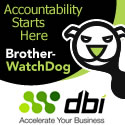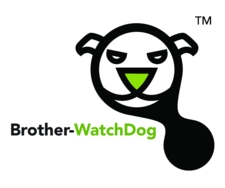
PCI Compliance
Requirement #10
Brother-WatchDog® Solution
Requirement 10 requires companies to "track and monitor all access to network resources and cardholder data." Brother-WatchDog addresses the requirement and sub-requirements by providing the ability to identify:- Who (web users, client users, analysts, SYS, SYSDBA, and SYSOPER users) initiated data access or updates
- What data was accessed or updated
- Where the activity originated
- When the database activity occurred (date and time)
- Whether access or updates succeeded or failed
- How Much data was impacted (DB2 only)

Protect the Innocent
Prosecute the Guilty
Achieve Accountability
(Click Image to learn more)

Achieve PCI DSS Compliance
with Brother-WatchDog®
Private Card Industry Data Security Standard (PCI DSS) compliance is required of all merchants and service providers that store, process, or transmit cardholder data on behalf of any of the major card issuers. The program applies to all payment channels, including retail (brick-and-mortar), mail/telephone order, and e- commerce.
PCI DSS consists of 12 requirements and sub-requirements that companies must adhere to in order to be compliant. Of the 12, Requirement 10 is considered to be one of the most important and difficult to address. Fortunately, Brother-WatchDog enables companies to quickly and easily address Requirement 10 right out of the box.
PCI Requirement 10
Track and monitor all access to network resources and cardholder data. Logging mechanisms and the ability to track user activities are critical. The presence of logs in all environments allows thorough tracking and analysis when something does go wrong. Determining the cause of a compromise is very difficult without system activity logs.
| PCI Requirement | Brother-WatchDog® |
| 10.1 - Establish a process for linking all access to system components (especially those done with administrative privileges such as root) to an individual user. | Yes |
|
10.2 -
Implement automated audit trails to reconstruct the following events, for all system components:
10.2.1 - All individual accesses to cardholder data 10.2.2 - All actions taken by any individual with root or administrative privileges 10.2.3 - Access to all audit trails 10.2.4 - Invalid logical access attempts 10.2.5 - Use of identification and authentication mechanisms 10.2.6 - Initialization of the audit logs 10.2.7 - Creation and deletion of system-level objects |
Yes |
|
10.3 -
Record at least the following audit trail entries for each event, for all system components:
10.3.1 - User identification 10.3.2 - Type of event 10.3.3 - Date and Time 10.3.4 - Success or failure indication 10.3.5 - Origination of Event 10.3.6 - Identity or name of affected data, system component, or resource. |
Yes |
|
10.5 -
Secure audit trails so they cannot be altered, including the following:
10.5.1 - Limit viewing of audit trails to those with a job-related need 10.5.2 - Protect audit trail files from unauthorized modifications 10.5.3 - Promptly back-up audit trail files to a centralized log server or media that is difficult to alter 10.5.5 - Use file integrity monitoring/change detection software (such a Tripwire) on logs to ensure that existing log data cannot be changed without generating alerts (although new data being added should not cause an alert). |
Yes |
| 10.6 - Review logs for all system components at least daily. Log reviews should include those servers that perform security functions like IDS and authentication (AAA) servers (e.g RADIUS). | Yes |
| 10.7 - Retain your audit trail history for a period that is consistent with its effective use, as well as legal regulations. | Yes |
Key Features
- Track connections (Logins and Logouts)
- Easily audit specific users, power users, DBAs, DDL activity (Create, Alter, Drop...), and security changes (Grants, Revokes)
- Unmask otherwise anonymous insider identities of privileged data users
- Reveal detailed database activity records for web end users, database clients and data analysts, and local administrative users
- Create and schedule periodic reports, notifications, alerts, and to conduct simple GoogleŽ-like ad hoc discovery searches
- E-mail notifications based on defined audit rules
- Tamper Evident Seals (digital signatures) harden audit activity data to ensure its accuracy
FREE PCI Compliance PDF
Download PCI DSS Compliance PDF
![]() Click Here to Download
Click Here to Download
How can we help?
DBI would be pleased to assist you in any way we can.
![]() Contact DBI
Contact DBI